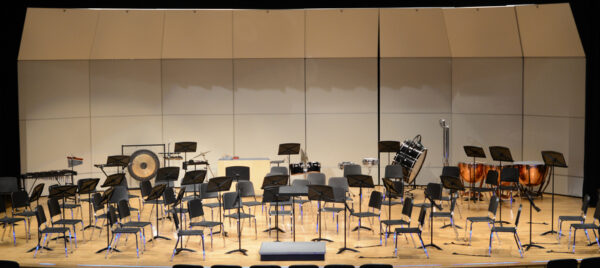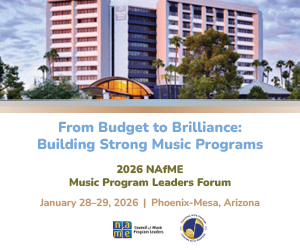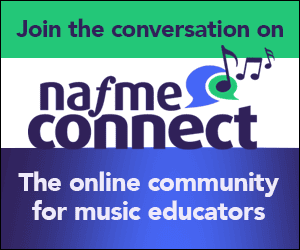/ News Posts / From the Podium to the Publisher
From the Podium to the Publisher
Finding Methods that Support Your Teaching
By Chase Banks, sponsored by NAfME Corporate member Hal Leonard
As a beginning band student, my very first note came from the Essential Elements method book. Years later, as a band director, that same method guided my students through their first notes, first concerts, and countless musical milestones. Today, I’m honored to contribute to the very team that’s ushering Essential Elements into a new era—one that supports the needs of modern classrooms while keeping music education accessible, engaging, and impactful for all students.
Having experienced this journey from multiple perspectives—as a student, educator, and now a music industry professional—I aim to share how advancements in our field, including digital tools and supplemental resources, can seamlessly integrate into any curriculum and elevate programs of all sizes.
For many music educators, method books are the backbone of our instructional approach. That’s why it’s so exciting to see legacy brands like the Essential Elements series—trusted in classrooms for over 30 years—refreshed and reimagined to meet the evolving needs of both teachers and students, all while preserving the pedagogical foundation that has made it a cornerstone in music education.
What to Look for in a Method Book?
Selecting a method book for your music program is one of the most important decisions you’ll make as a music educator. The method you choose becomes the foundation of your instruction, shaping not only what your students learn but how they learn it. Regardless of the method book you use, every teacher looks for different things. Here are a few essential questions to guide your decision when choosing a method book:
Does it offer a robust pedagogical framework?
A quality method book should be rooted in sound music education pedagogy—carefully sequenced, developmentally appropriate, and flexible enough to support students with diverse learning needs. Essential Elements has been trusted by educators for over 30 years for its logical progression of skills, clear learning targets, and balanced approach to tone, technique, rhythm, and theory.
Is it adaptable to your specific classroom setting?
Whether you teach large ensembles, small groups, or private lessons, your method book should support your teaching environment. Does it work for any band or orchestra setting? What about in hybrid or virtual classrooms? Look for a method that is adaptable to your needs.
Are there digital resources that support teaching and learning?
In today’s classrooms, having a digital component isn’t just a bonus—it’s essential. For instance, Essential Elements Interactive (EEi) provides teachers and students with access to a comprehensive online platform featuring over 400 instructional videos, audio play-alongs, practice tools, and recording capabilities. It enables differentiated instruction, flipped learning, and individualized assessment—all without requiring the purchase of additional tools. Look for a method book that includes correlated resources and materials that will complement the work completed in the rehearsal space.
Does it keep students engaged?
Engagement is critical, especially for beginning students. Meeting students where they are with music listening is a simple strategy for developing student engagement. If you’re an EE teacher, the recent addition of 50 new pop song arrangements in EEi from artists such as Chappell Roan, Olivia Rodrigo, and Taylor Swift provides fresh and exciting repertoire that keeps students motivated and connects classroom learning with the music they encounter in everyday life. These selections are leveled appropriately, allowing for real-world musical connections without sacrificing instructional integrity.
Is it inclusive and reflective of today’s classrooms?
Representation matters! Classroom resources should reflect a diverse and modern student population. The new editions of Essential Elements are compatible with previous versions, and the latest content helps every student feel seen and valued—something we should expect from every resource in our classroom.
Does it grow with your students?
A strong method should support students well beyond their first year. With fully updated editions available for Books 1, 2, and 3, Essential Elements provides a consistent pedagogical path that can carry students from their first note to advanced ensemble playing. That continuity allows teachers to build a vertically-aligned curriculum across grade levels.
Choosing a method book is about more than tradition—it’s about selecting a tool that supports your teaching style, empowers your students, and prepares your program for success. For decades, Essential Elements has done just that—and with these recent updates, it’s ready to meet the needs of today’s classrooms better than ever before.
Want to explore the new Essential Elements methods?
 If you’re curious about the new books, use the link below to preview and download Books 1, 2, & 3 for Band and Strings:
If you’re curious about the new books, use the link below to preview and download Books 1, 2, & 3 for Band and Strings:
As someone who’s been on both sides of the podium, I know how important it is to have reliable, thoughtful resources in your corner. Essential Elements was there for me as a student, helped me succeed as a teacher, and continues to inspire my work today. Because now more than ever, music is essential. And so are you!
About the author:
 Chase Banks is the Marketing Manager at Hal Leonard, a former Band Director, and lifelong music educator.
Chase Banks is the Marketing Manager at Hal Leonard, a former Band Director, and lifelong music educator.
Interested in reprinting this article? Please review the reprint guidelines.
The National Association for Music Education (NAfME) provides a number of forums for the sharing of information and opinion, including blogs and postings on our website, articles and columns in our magazines and journals, and postings to our Amplify member portal. Unless specifically noted, the views expressed in these media do not necessarily represent the policy or views of the Association, its officers, or its employees.
Published Date
June 26, 2025
Category
- Ensembles
- Innovation
- Repertoire
- Representation
- Technology
Copyright
June 26, 2025. © National Association for Music Education (NAfME.org)





